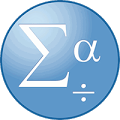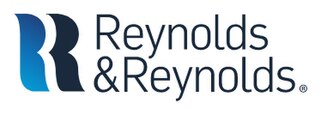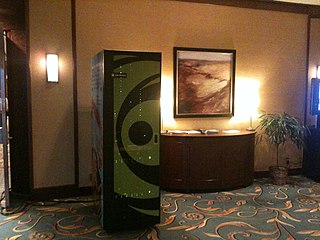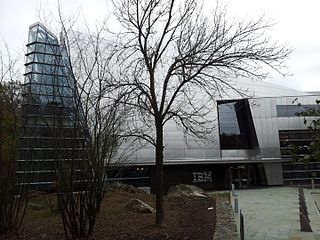
Optical character recognition or optical character reader (OCR) is the electronic or mechanical conversion of images of typed, handwritten or printed text into machine-encoded text, whether from a scanned document, a photo of a document, a scene photo or from subtitle text superimposed on an image.
Lotus Software was an American software company based in Massachusetts; it was sold to India's HCL Technologies in 2018.

Wang Laboratories, Inc., was an American computer company founded in 1951 by An Wang and G. Y. Chu. The company was successively headquartered in Cambridge, Massachusetts (1954–1963), Tewksbury, Massachusetts (1963–1976), and finally in Lowell, Massachusetts (1976–1997). At its peak in the 1980s, Wang Laboratories had annual revenues of US$3 billion and employed over 33,000 people. It was one of the leading companies during the time of the Massachusetts Miracle.

SPSS Statistics is a statistical software suite developed by IBM for data management, advanced analytics, multivariate analysis, business intelligence, and criminal investigation. Long produced by SPSS Inc., it was acquired by IBM in 2009. Versions of the software released since 2015 have the brand name IBM SPSS Statistics.

Handwriting recognition (HWR), also known as handwritten text recognition (HTR), is the ability of a computer to receive and interpret intelligible handwritten input from sources such as paper documents, photographs, touch-screens and other devices. The image of the written text may be sensed "off line" from a piece of paper by optical scanning or intelligent word recognition. Alternatively, the movements of the pen tip may be sensed "on line", for example by a pen-based computer screen surface, a generally easier task as there are more clues available. A handwriting recognition system handles formatting, performs correct segmentation into characters, and finds the most possible words.
Electronic business is any kind of business or commercial transaction that includes sharing information across the internet. Commerce constitutes the exchange of products and services between businesses, groups, and individuals and can be seen as one of the essential activities of any business.
Optical mark recognition (OMR) collects data from people by identifying markings on a paper. OMR enables the hourly processing of hundreds or even thousands of documents. A common application of this technology is used in exams, where students mark cells as their answers. This allows for very fast automated grading of exam sheets.

OpenText Corporation is a Canadian Information company that develops and sells enterprise information management (EIM) software.
Lexmark International, Inc. is a privately held American company that manufactures laser printers and imaging products. The company is headquartered in Lexington, Kentucky. Since 2016 it has been jointly owned by a consortium of three multinational companies: Apex Technology, PAG Asia Capital, and Legend Capital.
Enterprise content management (ECM) extends the concept of content management by adding a timeline for each content item and, possibly, enforcing processes for its creation, approval, and distribution. Systems using ECM generally provide a secure repository for managed items, analog or digital. They also include one methods for importing content to manage new items, and several presentation methods to make items available for use. Although ECM content may be protected by digital rights management (DRM), it is not required. ECM is distinguished from general content management by its cognizance of the processes and procedures of the enterprise for which it is created.
Tungsten Automation, formerly Kofax Inc., is an Irvine, California-based intelligent automation software provider. Founded in 1985, the company's software allows businesses to automate and improve business workflows by simplifying the handling of data and documents.

The Reynolds and Reynolds Company is a private corporation based in Dayton, Ohio. Its primary business is providing business forms, management software and professional services to car dealerships. Its software is used to manage sales logistics at dealerships. It also produces forms used in medicine and insurance.
TeleForm is a form of processing applications originally developed by Cardiff Software and now is owned by OpenText.
ReadSoft was a global provider of applications for automating business processes. ReadSoft was founded by two university students in Linköping, Sweden, in 1991. The company was headquartered in Helsingborg, Sweden and its shares were traded on the NASDAQ OMX – Stockholm Small Cap list. ReadSoft had operations in 17 countries and a partner network in an additional 70 nations.
Epicor Software Corporation is a business software company based in Austin, Texas founded in 1972. Its products are aimed at the manufacturing, distribution, retail and services industries.

FileNet Corporation, a company acquired by IBM, developed software to help enterprises manage their content and business processes. FileNet P8, their flagship offering, is a framework for developing custom enterprise systems, but it can be used as-is.

IBM Netezza is a subsidiary of American technology company IBM that designs and markets high-performance data warehouse appliances and advanced analytics applications for the most demanding analytic uses including enterprise data warehousing, business intelligence, predictive analytics and business continuity planning.

Hitachi Data Systems (HDS) was a provider of modular mid-range and high-end computer data storage systems, software, and services. Its operations are now a part of Hitachi Vantara.

International Business Machines Corporation, nicknamed Big Blue, is an American multinational technology company headquartered in Armonk, New York and present in over 175 countries. IBM is the largest industrial research organization in the world, with 19 research facilities across a dozen countries, having held the record for most annual U.S. patents generated by a business for 29 consecutive years from 1993 to 2021.










